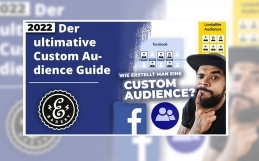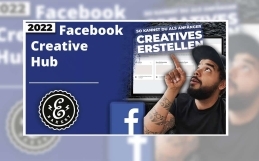Paid Ads Tutorial
What is paid advertising and how do you place it?
In this Paid Ads tutorial, Luciano explains what paid advertising is on social media platforms, who should and shouldn’t use it, and teaches you the basics of paid ads metrics. All this in this video.
Why Paid Ads?
Let’s start into the topic. So, why should I bother with paid ads? The question is actually answered relatively quickly: Because your competition does it too. Imagine that your competitors are running paid ads in addition to offline ads, get data about customers who are already relatively interested in your product and get additional customers via the algorithm.
What then happens to the one who does not do exactly that? There’s a saying – either you move with the times or you move with the times, and that’s exactly the case here. Therefore, it is mandatory for any growth-oriented business to deal with paid ads.
Paid Ads Tutorial - For whom does it make sense?
Let’s move on to the question: for whom do paid ads make sense? It’s really quite simple to say “for anyone who wants to make money”, or for any person who needs to or should generate reach, for any business, whether that’s a coach selling coaching, mentoring, or a real estate company that wants to get rid of real estate, or products, very simple fashion products housewares, so theoretically ads work for any growth-oriented business. Now when you outline it like that, you ask yourself “then of course ads don’t make sense for who?” That would be relatively simple to explain: Ads are always associated with a budget and if the budget is too low, as an example: you are a used car dealer and simply sell vehicles that are under 500 € in value, then you have somewhere probably bought it for 400€ or 350€ and have only 150 € margin. If you run ads now and you don’t manage to go viral in a big way, then the budget may eat up that margin and it doesn’t make sense. Or you want to sell your vehicle privately and cannot afford to invest a certain amount X to generate the range for it.
Paid Ads Tutorial - How they work
It is also important to understand that ads are designed to build a secure data set that ensures that you will reach the same customers again in a similar way. The data sets are actually the be-all and end-all, and here we come back to the point: for whom do ads make sense? And this is really very important to understand now. Make sense now most for the person who already make sales, those who already sell products. Because let’s take a simple example: a fashion online store that simply sells fashion and this sells anyway. This means that the site has a certain amount of traffic and through the tracking that you set up with the ads, the algorithm of the platform you are using gets to know your customers better and better and uses its own platform to search for more customers. This is called scaling, and that is the purpose of any growth-oriented company. Thus, for companies that are already successful, paid ads are a tremendous boost. Or let’s take coaching and mentoring courses: Most of the time these are high priced and this creates some margin, some margin that you can use as a budget for paid ads. There it makes sense to use paid ads to get to know your target group. The fact that you might learn who your target audience is through tracking alone makes paid ads and the tracking behind them incredibly ingenious. And that’s why you have to ask yourself, if I can increase my sales or even just profit by 10, 20 or 35 percent without any extra effort – of course you pay the budget but that comes back through your sales or profit – you have to ask yourself “can I afford to let it happen?”
The function
Let’s move on to the question: how do paid ads work? Relatively simple to understand. Everyone knows what cookies are: they are the little things you print in milk and then eat and… No, okay, all kidding aside, we’re talking more about website tracking now.
It is now standard that each site must approve or the user must approve that the cookies are tracked. And simple principle: you have your platform, with this platform you have integrated a tracking to your site and this tracking runs in the background when the customer moves on your site. By the way, this tracking is a rocket science in itself, that’s why there are specialists for it and the better this tracking is set up, the better the whole paid ad system runs, but we might get to that later.
What is tracking?
Accordingly, the tracking is the basis for the algorithm of the respective platform. There are multiple platforms, there’s something like Facebook, there’s Instagram, there’s Pinterest, there’s TikTok, there’s LinkedIn there’s even Yodel, you can run ads on Yodel, now also on Spotify. So when tracking is set up perfectly, an algorithm learns in the background what a target group is. Of course, this only works if you either already have traffic, or you’re generating traffic via paid ads that you didn’t have before to find out who your target audience is. To find out who your target audience is, say you are starting from scratch with Paid Ads, simply because you have a project that needs to work completely without records. It is even more important that you take care of the copies and the creatives in the paid ads, because the copies and the creatives are the basis for addressing the customer. Say a Copy is nothing but the text, a Creative is nothing but the image, or the video you use. This in turn means Copy, Creative and the third element is an offer. Whether you’re a coach, or whether it’s a jacket, from some big online retailer in the fashion space, your deal. These three things make the difference about whether a customer listens to you or not, whether it works or not, whether the customer keeps scrolling or not. Again, this is also rocket science in its own right, as most customers simply have an attention span of around 3 to 5 seconds, meaning the first few seconds are crucial in determining whether the ad is relevant to the customer. And that’s where the second variable comes in, that the algorithm has its own understanding of how to rank you with your ad, how relevant you are. Speak if you do this standard advertising, as many entrepreneurs is simply unfortunately very make. Speak any video with me at all that, and that, and that, and that is quite great and that is now also cheap and have the whole. Then it may well be that your relevance in the respective platform – let’s take Facebook as an example – your relevance of the ad simply drops. You can then shoot in a lot of budget as you want and still it does not work because the platform has noticed that too many customers identify you as advertising have no interest in your offer and just keep scrolling and then you burn budget unfortunately that’s why Paid Ads is a or the topic of media buying so important.
Paid Ads Tutorial - Which platforms to advertise on?
Once you understand the need for paid ads, the next question is: what platform do I use for it?
I mean, there’s like I said before: Facebook, Instagram, Pinterest, TikTok, LinkedIn, Xing, Yodel, Spotify, and soon Netflix, by the way. And that begs the question, “Which of the platforms do I put my ads on?” And that is mostly target group dependent. Let’s take a simple example: Pinterest is 70% visited by women. Thank goodness you can find out in advance for each platform what the target group looks like, or how large the audience is in general, and what the audience looks like. At TikTok, it’s mostly younger, but it still plays a very strong role. So that you know how much reach you can generate through this platform, and whether this platform might make more sense for you than another. However, it should also be noted that on each platform you have the possibility to customize your ads or your campaigns in such detail that if you already know your target audience, you can target them yourself. Male, female, age, fields of interest, there are platforms that work with interest targeting – targeting is nothing more than targeting customers with interests and keywords, for example, the difference between Facebook and Google is that Facebook is creative and has a targeted setting of the target group, and Google works word-based on keywords, as far as you use the topic of paid ads, you do not use SEO.
Paid Ads Tutorial - Summary
To answer the question in conclusion, it really only means the platform differ by audience and you need to know the audience so you know which platform you want to serve.
So let’s keep it simple – for whom do paid ads make sense?
For any growth-oriented company. But what does it depend on whether ad campaigns are successful or not? Of course, that again depends on your definition of success. However, first and foremost, understanding the metrics is a mandatory part of it. Thus you can e.g. test several platforms like Facebook, Pinterest or Spotify with a small budget and know afterwards where your target group is more likely to be located. Within these platforms, there is then a respective backend that needs to be understood. The structure is always slightly different, even if the metrics are mostly the same.
But which metrics exactly are, we will explain to you in one of the next articles.
However, if you don’t want to understand the matter, but simply want to achieve success and concentrate on your main business, then we at eBakery are happy to support you as an ads but also social media agency. Please feel free to make an appointment directly.
Do you have questions or need an individual offer? Do not hesitate to contact us.
- 0/5
- 0 ratings
| Very bad! | Bad | Hmmm | Oke | Good! |
|---|---|---|---|---|
| 0% | 0% | 0% | 0% | 0% |
Haben Sie Fragen oder brauchen ein individuelles Angebot? Zögern Sie nicht, uns zu kontaktieren.



















